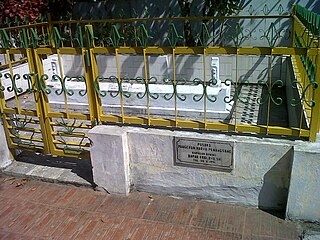
The Kingdom of Pajang or Sultanate of Pajang was a short-lived Muslim state in Java. It was established by Hadiwijaya or Jaka Tingkir, Lord of Boyolali, after a civil war and was a successor to Sultanate of Demak. Hadiwijaya claimed to be a descendant of Brawijaya V, the last king of the Majapahit empire, and Trenggana, the sultan of Demak.

Demak Great Mosque is one of the oldest mosques in Indonesia, located in the center town of Demak, Central Java, Indonesia. The mosque is believed to have been built by the Wali Songo with the most prominent figure Sunan Kalijaga, during the first Demak Sultanate ruler, Raden Patah during the 15th century.

Amangkurat I was the susuhunan of the Mataram Sultanate from 1646 to 1677.

Kyai Haji Ahmad Dahlan, often abbreviated to K.H. Ahmad Dahlan, was an Indonesian Muslim religious leader and revivalist, who established the Muhammadiyah organization. Which would become one of the largest Muslim organizations in Indonesia, second only to the Nahdlatul Ulama. Born in Kauman, Yogyakarta, he was the son of an imam of a local mosque and traced his origins from the lineage of Muhammad. Ahmad Dahlan performed the Hajj pilgrimage when he was 15 years old, and he lived in Mecca for another five years.

The Demak Sultanate was a Javanese Muslim state located on Java's north coast in Indonesia, at the site of the present-day city of Demak. A port fief to the Hindu-Buddhist Majapahit kingdom thought to have been founded in the last quarter of the 15th century, it was influenced by Islam brought by Muslim traders from China, Gujarat, Arabia and also Islamic kingdoms in the region, such as Samudra Pasai, Malacca and Bani (Muslim) Champa. The sultanate was the first Muslim state in Java, and once dominated most of the northern coast of Java and southern Sumatra.
Sunan Ampel was one of the Javanese nine revered saints Wali Songo, credited for the spread of Islam in Java. According to local history around Demak the mosque of Demak Masjid Agung Demak was built by Sunan Ampel in 1479 CE, but other sources credited the construction of the mosque to Sunan Kalijaga.

The Sultanate of Cirebon was an Islamic sultanate in West Java founded in the 15th century. It is said to have been founded by Sunan Gunungjati, as marked by his letter proclaiming Cirebon's independence from Pajajaran in 1482, although the settlement and the polity had been established earlier, in 1445. Sunan Gunungjati also established the Sultanate of Banten. It was one of the earliest Islamic states established in Java, along with the Sultanate of Demak.

Kalinyamat Sultanate or Kalinyamat Kingdom, was a 16th-century Javanese Islamic polity in the northern part of the island of Java, centred in modern-day Jepara, Central Java, Indonesia.
Serat Centhini is a twelve-volume compilation of Javanese tales and teachings, written in verse and published in 1814. The work was commissioned, directed, and partially written by Crown Prince Mangkunegoro, later enthroned as Pakubuwono V of Surakarta, with contributions from three court poets from different palaces.

Raden Patah, also known as Jin Bun was the first sultan of the Demak Sultanate. Ascending to the throne in 1475, his remained a vassal of the Majapahit Empire until 1478. Raden Patah took the title Panembahan Jimbun after legitimizing the Sultanate of Demak as the successor state to the Majapahit Empire, with Wali Sanga appointing him as the Sultan of Demak.
Pakubuwono I, uncle of Amangkurat III of Mataram was a combatant for the succession of the Mataram dynasty, both as a co-belligerent during the Trunajaya rebellion, and the First Javanese War of Succession (1704–1707).

Arya Penangsang was king of the Sultanate of Demak between 1549 and 1554.
Prabhu Natha Girindrawardhana Dyah Ranawijaya was the ruler of the Majapahit Empire between 1474 and 1498. He is referred in a Jiyu inscription as Sri Wilwatikta Jenggala Kediri, which means ruler of Majapahit, Janggala and Kediri, and as Pa Bu Ta La in Chinese literature.
Panembahan Senapati, formally styled Panembahan Senapati ing Ngalaga Sayyidin Panatagama, was the founder of the Mataram Sultanate.
Joko, Jaka, or Djoko is a Javanese male name which means "young unmarried man" or "boy". Notable people with this name include:
Sunan Bungkul, whose real name is Ki Ageng Supo or Mpu Supo, was a nobleman from the time of the Majapahit Kingdom, who after converting to Islam used the name Ki Ageng Mahmuddin. He was one of the spreaders of Islam in the late 15th century in the Majapahit Kingdom. He is the son-in-law of Sunan Ampel, although some say he is the father-in-law of Raden Paku, who is better known as Sunan Giri. He is estimated to have lived during the Sunan Ampel period of 1400–1481 M. He had a daughter named Dewi Wardah. His tomb is directly behind Taman Bungkul Surabaya.

Giri Kedaton was an Islamic kedatuan located in Gresik, East Java and existed in the 15th to 17th centuries, until Giri was conquered by the Mataram Sultanate in 1636.

The Mempawah Kingdom also known as the Mempawah Sultanate, was an Islamic Dayak kingdom located in a territory now known as the Mempawah Regency, West Kalimantan, Indonesia. The name Mempawah is taken from the term "Mempauh", which is the name of a tree that grows in the upper reaches of the river, also known as the Mempawah River. In its development, Mempawah became known as the name of one of the kingdoms and sultanates that developed in West Borneo. The history of Mempawah is divided into two periods, namely the Dayak kingdom based on Hindu teachings and the period of Islamic influence.
Ki Ageng Ngenis was an Indonesian preacher who played a role in preaching Islam in Surakarta. He was the father of Ki Ageng Pamanahan and the grandfather of Senapati of Mataram.








